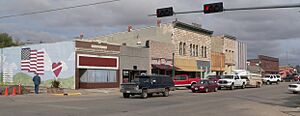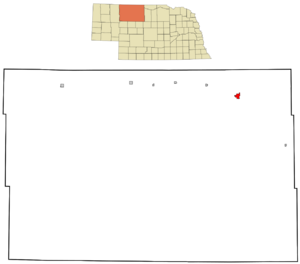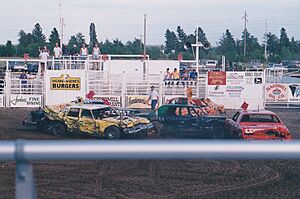Valentine, Nebraska facts for kids
Quick facts for kids
Valentine, Nebraska
|
||
|---|---|---|

Main Street (2010)
|
||
|
||
| Nickname(s):
America's Heart City
|
||

Location of Valentine, Nebraska
|
||
| Country | United States | |
| State | Nebraska | |
| County | Cherry | |
| Area | ||
| • Total | 2.65 sq mi (6.85 km2) | |
| • Land | 2.63 sq mi (6.82 km2) | |
| • Water | 0.01 sq mi (0.03 km2) | |
| Elevation | 2,579 ft (786 m) | |
| Population
(2020)
|
||
| • Total | 2,633 | |
| • Density | 999.24/sq mi (385.84/km2) | |
| Time zone | UTC−6 (Central (CST)) | |
| • Summer (DST) | UTC−5 (CDT) | |
| ZIP code |
69201
|
|
| Area code(s) | 402 | |
| FIPS code | 31-49950 | |
| GNIS ID | 2397108 | |
Valentine is a city in Nebraska, United States. It is the main town in Cherry County, Nebraska. In 2010, about 2,737 people lived there. Valentine is sometimes called "America's Heart City."
Contents
History of Valentine
Valentine was started in 1882. The first post office opened on December 4, 1882. A train line, the Sioux City and Pacific Railroad, reached Valentine in 1883, bringing train service on April 1. The city was named after Edward K. Valentine, who was a representative for Nebraska.
For a long time, Valentine was unique because it was split between two time zones. The Mountain Time Zone and Central Time Zone met right in the middle of Main Street! This meant that the two sides of the street were an hour apart. When daylight saving time changed, the post office even turned its clock back by half an hour to split the difference.
Every year, Valentine takes part in a special re-mailing program. Thousands of letters are sent to the Valentine post office. Then, they are re-mailed with a special Valentine's Day postmark and a sweet message. This makes them extra special for people who receive them.
In 2007, National Geographic Adventure magazine named Valentine one of the top 100 adventure towns and cities. This shows it's a great place for outdoor fun!
In the Lakota language, Valentine has two names. One is Oínažiŋ, which means "station stopping place." The other is Mnináȟaȟa Otȟúŋwahe, meaning "water and waterfall city."
Geography and Nature
Valentine is a city that covers about 2.25 square miles (5.83 square kilometers). Most of this area is land, with a small part being water.
The city is located just north of the Niobrara River. It sits on the northern edge of the Sandhills, which is a unique area of grassy sand dunes. About 30 miles (50 km) southwest of Valentine is Merritt Reservoir. This lake was made by a dam on the Snake River.
You can find some amazing waterfalls near Valentine:
- Snake River Falls is Nebraska's largest waterfall. It's on the Snake River, not far from the reservoir.
- Smith Falls is Nebraska's tallest waterfall. It's about 15 miles (24 km) east of Valentine.
Just south of Valentine, two bridges cross the Niobrara River. One is a modern bridge for U.S. Route 83. Next to it is the Bryan Bridge, an old cantilever truss bridge built in 1932. It's made of steel and is listed as a historic place. At the north end of Main Street, there's a large red neon heart on a pine-covered canyon wall. During Christmas, it changes to a star!
Climate and Weather
Valentine has a humid continental climate. This means it gets very hot in summer and very cold in winter. The average temperature in January is about 24.5°F (minus 4.2°C). In July, it's around 75.7°F (24.3°C).
On average, the temperature reaches 100°F (38°C) or higher about seven days a year. It gets to 90°F (32°C) or higher about 41 days a year. In winter, the temperature stays below freezing about 41 days a year. It drops to 0°F (minus 18°C) or lower about 18 mornings a year.
The lowest temperature ever recorded was minus 39°F (minus 39°C) in December 1989. The highest was 114°F (46°C) in July 1990.
Valentine doesn't get a lot of rain, averaging about 20.90 inches (531 mm) per year. Winters are very dry. Snowfall is moderate, averaging about 34.2 inches (87 cm) per season. Most snow falls in February and March.
| Climate data for Valentine, Nebraska (Miller Field), 1991–2020 normals, extremes 1889–present | |||||||||||||
|---|---|---|---|---|---|---|---|---|---|---|---|---|---|
| Month | Jan | Feb | Mar | Apr | May | Jun | Jul | Aug | Sep | Oct | Nov | Dec | Year |
| Record high °F (°C) | 72 (22) |
78 (26) |
87 (31) |
100 (38) |
102 (39) |
110 (43) |
114 (46) |
108 (42) |
106 (41) |
96 (36) |
86 (30) |
76 (24) |
114 (46) |
| Mean maximum °F (°C) | 60.8 (16.0) |
64.8 (18.2) |
77.1 (25.1) |
84.6 (29.2) |
91.4 (33.0) |
97.2 (36.2) |
103.4 (39.7) |
101.2 (38.4) |
97.0 (36.1) |
87.5 (30.8) |
74.9 (23.8) |
61.1 (16.2) |
104.5 (40.3) |
| Mean daily maximum °F (°C) | 37.8 (3.2) |
40.9 (4.9) |
51.6 (10.9) |
61.2 (16.2) |
72.0 (22.2) |
83.0 (28.3) |
90.4 (32.4) |
88.4 (31.3) |
79.8 (26.6) |
64.5 (18.1) |
50.6 (10.3) |
39.4 (4.1) |
63.3 (17.4) |
| Daily mean °F (°C) | 24.5 (−4.2) |
27.6 (−2.4) |
37.6 (3.1) |
47.2 (8.4) |
58.1 (14.5) |
69.0 (20.6) |
75.7 (24.3) |
73.6 (23.1) |
64.2 (17.9) |
49.3 (9.6) |
36.2 (2.3) |
26.3 (−3.2) |
49.1 (9.5) |
| Mean daily minimum °F (°C) | 11.2 (−11.6) |
14.2 (−9.9) |
23.5 (−4.7) |
33.1 (0.6) |
44.2 (6.8) |
54.9 (12.7) |
61.0 (16.1) |
58.7 (14.8) |
48.6 (9.2) |
34.2 (1.2) |
21.8 (−5.7) |
13.1 (−10.5) |
34.9 (1.6) |
| Mean minimum °F (°C) | −14.0 (−25.6) |
−10.2 (−23.4) |
0.1 (−17.7) |
14.6 (−9.7) |
27.6 (−2.4) |
40.8 (4.9) |
47.9 (8.8) |
44.9 (7.2) |
31.5 (−0.3) |
15.1 (−9.4) |
0.1 (−17.7) |
−9.9 (−23.3) |
−20.3 (−29.1) |
| Record low °F (°C) | −38 (−39) |
−37 (−38) |
−29 (−34) |
−8 (−22) |
17 (−8) |
30 (−1) |
38 (3) |
34 (1) |
12 (−11) |
−6 (−21) |
−22 (−30) |
−39 (−39) |
−39 (−39) |
| Average precipitation inches (mm) | 0.32 (8.1) |
0.61 (15) |
1.01 (26) |
2.48 (63) |
3.52 (89) |
3.96 (101) |
2.82 (72) |
2.04 (52) |
1.72 (44) |
1.42 (36) |
0.57 (14) |
0.43 (11) |
20.90 (531) |
| Average snowfall inches (cm) | 4.4 (11) |
6.5 (17) |
6.0 (15) |
5.6 (14) |
0.1 (0.25) |
0.0 (0.0) |
0.0 (0.0) |
0.0 (0.0) |
0.0 (0.0) |
2.0 (5.1) |
4.6 (12) |
5.0 (13) |
34.2 (87) |
| Average precipitation days (≥ 0.01 in) | 4.9 | 5.7 | 6.9 | 9.6 | 11.8 | 11.2 | 9.3 | 8.1 | 6.8 | 7.2 | 4.8 | 4.8 | 91.1 |
| Average snowy days (≥ 0.1 in) | 3.8 | 4.7 | 4.0 | 2.4 | 0.1 | 0.0 | 0.0 | 0.0 | 0.0 | 1.1 | 2.9 | 3.9 | 22.9 |
| Average relative humidity (%) | 64.4 | 64.6 | 62.9 | 55.4 | 57.4 | 55.7 | 54.9 | 57.6 | 54.5 | 57.3 | 62.4 | 64.3 | 59.3 |
| Average dew point °F (°C) | 8.8 (−12.9) |
12.7 (−10.7) |
21.6 (−5.8) |
29.3 (−1.5) |
40.8 (4.9) |
50.0 (10.0) |
55.0 (12.8) |
54.0 (12.2) |
42.8 (6.0) |
30.9 (−0.6) |
19.8 (−6.8) |
10.2 (−12.1) |
31.3 (−0.4) |
| Mean monthly sunshine hours | 181.7 | 183.2 | 216.2 | 239.8 | 284.4 | 317.2 | 349.6 | 325.4 | 264.0 | 232.5 | 175.0 | 163.0 | 2,932 |
| Percent possible sunshine | 62 | 62 | 58 | 60 | 63 | 69 | 75 | 75 | 70 | 68 | 60 | 58 | 66 |
| Source: NOAA (relative humidity and dew point 1976–1990, sun 1961–1990) | |||||||||||||
People Living in Valentine
| Historical population | |||
|---|---|---|---|
| Census | Pop. | %± | |
| 1900 | 811 | — | |
| 1910 | 1,098 | 35.4% | |
| 1920 | 1,596 | 45.4% | |
| 1930 | 1,672 | 4.8% | |
| 1940 | 2,188 | 30.9% | |
| 1950 | 2,700 | 23.4% | |
| 1960 | 2,875 | 6.5% | |
| 1970 | 2,662 | −7.4% | |
| 1980 | 2,829 | 6.3% | |
| 1990 | 2,826 | −0.1% | |
| 2000 | 2,820 | −0.2% | |
| 2010 | 2,737 | −2.9% | |
| 2020 | 2,633 | −3.8% | |
| U.S. Decennial Census 2012 Estimate |
|||
In 2010, there were 2,737 people living in Valentine. These people made up 1,259 households.
Most people in Valentine (86.3%) were White. About 9.1% were Native American. A small number were from other groups. About 1.6% of the population was Hispanic or Latino.
The average age of people in Valentine was 46 years old.
- About 21.3% of residents were under 18.
- About 24% were 65 years or older.
- The city had slightly more females (52.8%) than males (47.2%).
Education in Valentine
Valentine is part of the Valentine Community Schools district.
The schools in Valentine include:
- Valentine Elementary School
- Valentine Middle School
- Valentine High School
There are also private schools:
- Grace Lutheran School
- Zion Lutheran School
Getting Around Valentine
Valentine has a bike-sharing program called Valentine Bike Share. You can find a station along the Cowboy Trail, which is a path for bikes and walkers. Open Plains Transit offers a dial-a-ride service on weekdays. This means you can call for a ride when you need it.
Famous People from Valentine
Many interesting people have connections to Valentine:
- Lyman Lloyd Bryson was a famous CBS Radio broadcaster and educator.
- Edward Day Cohota was a Chinese-born veteran who fought in the American Civil War.
- James Dahlman served as the mayor of Omaha for many years.
- Clayton Danks was the model for the Wyoming state symbol of a cowboy on a bucking horse.
- Patrick Deuel was known for being one of the heaviest people in the world.
- Rebecca Donaldson, a character from the TV show Full House, said Valentine was her hometown.
- Deb Fischer, a U.S. Senator, has a ranch near Valentine.
- Tim Walz is the Governor of Minnesota and was a U.S. Representative. He is also the 2024 Democratic nominee for Vice President.
Culture and Entertainment
In 2011 and 2012, an independent movie called The Aviation Cocktail was filmed in Valentine.
See also
 In Spanish: Valentine (Nebraska) para niños
In Spanish: Valentine (Nebraska) para niños



